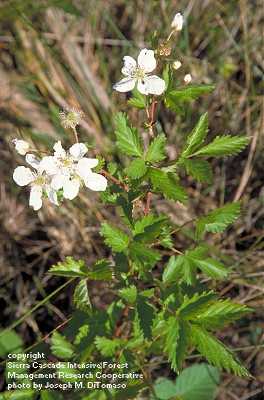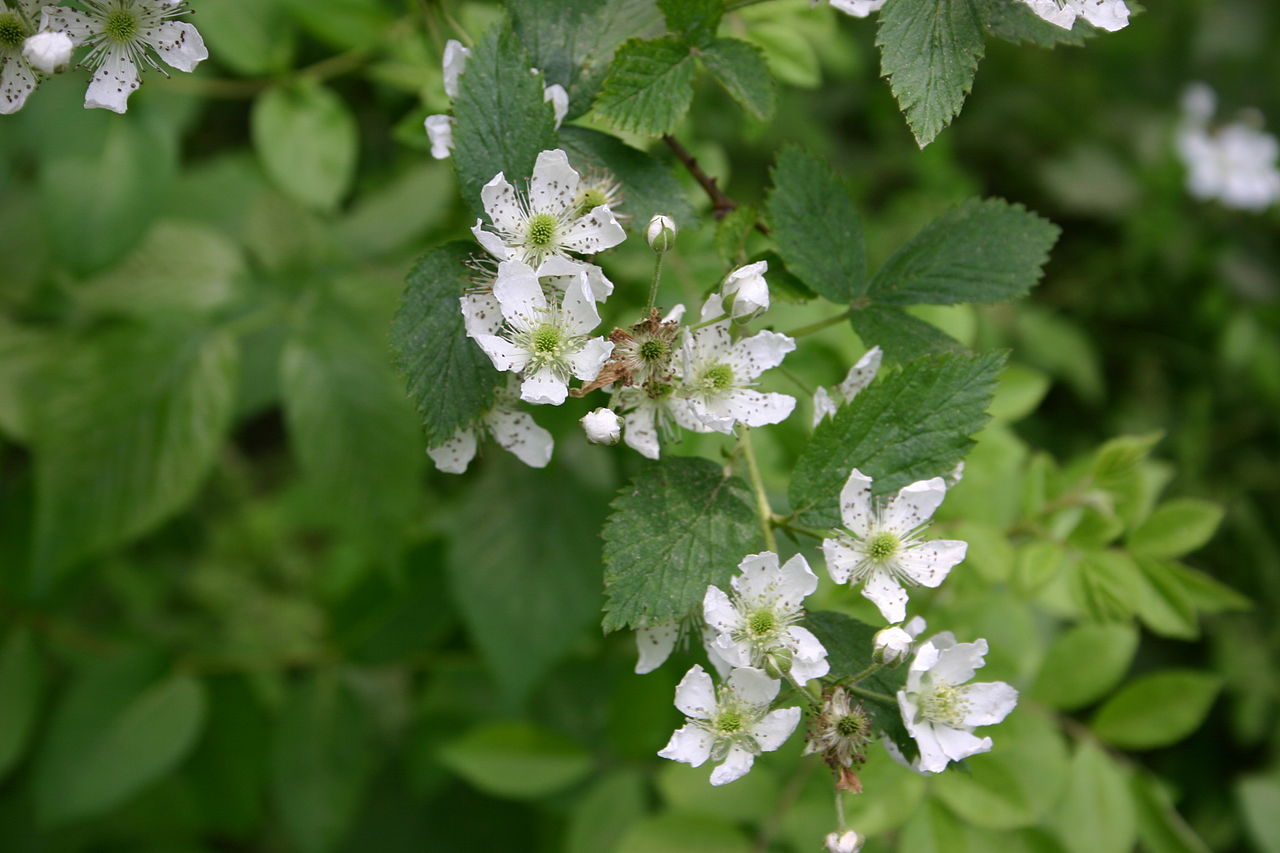 Download PDF
Download PDF
Name: Rubus pensilvanicus Poiret
Family: Rosaceae (the Rose family)
Common Names: Pennsylvania Blackberry, Yankee Blackberry, High Bush Blackberry (1, 5, 10).
 Etymology: Rubus in Latin means “bramble, blackberry, or raspberry” (16). Pensilvanicus means “of Pennsylvania”.
Etymology: Rubus in Latin means “bramble, blackberry, or raspberry” (16). Pensilvanicus means “of Pennsylvania”.
Botanical synonyms: Rubus abactus Bailey, R. alumus (L.H. Bailey) L.H. Bailey, Rubus ostryifolius Rydberg (4,6,7), and probably Rubus frondosus (15).
Quick Notable Features:
¬ Alternate, palmately compound 3-7 foliate leaves, green on both sides, pubescent beneath
¬ Stems with substantial straight or slightly reflexed prickles, but definitely not glandular
¬ Fruit black at maturity, an aggregate of drupelets that remain attached to the sepals at maturity
Plant Height: The erect or high-arching plant can be up to 3 m tall (9).
Subspecies/varieties recognized: none located in the literature
Most Likely Confused with: Other members of Rubus such as R. idaeus, R. laciniatus, R. occidentalis, R. flagellaris, R. hispidus, and R. allegheniensis. Among scrambling and climbing plants, it might also be confused with Rosa setigera, and Rosa multiflora.
Habitat Preference: Known from thickets, forest edges, recently burned areas, open woodlands and disturbed dune areas (9, 11, 18). In addition it increases “drastically” in clearcuts and multiple-tree cut areas (14).
Geographic Distribution in Michigan: R. pensilvanicus is found in most of the counties in the four southern-most tiers of counties in Michigan (19 of 28), but is sparsely scattered in counties further north in the Lower Peninsula as well as in the Upper Peninsula (2).
Known Elevational Distribution: R. pensilvanicus has been found at elevations of 2000m in California, where it is introduced and naturalized (12).
Complete Geographic Distribution: Native to eastern North America, R. pensilvanicus is also found as an introduced plant as far west as California (7). In its native range it extends from Newfoundland to Ontario in Canada, and from Minnesota south and eastward to South Carolina, Tennessee, and Alabama (1, 11).
Vegetative Plant Description: A perennial plant, which sends up vegetative stems from a “stemcrown” each year (20). The non-glandular leaves are compound, alternate, bearing 3-7 (most often 5) leaflets, generally arranged in a palmate manner. Leaves can bear thorns on the undersurfaces of both the petioles and blades, as well as often being pubescent on the undersurface. The leaflet margins are either singly or doubly serrate. The terminal leaflets are 6-20cm long and 4-10cm broad, basally rounded or cordate, ovate, acuminate (9). The stipules are linear, and leaflets are 6-12cm long while petiolules are 10-20mm long. The plant produces arched purplish canes that are generally thorny but not glandular (5, 7, 9, 11). The flower and fruit bearing leaves may only bear 3 leaflets or they can even be simple.
 Climbing Mechanism: Rubus pensilvanicus is a scrambler, using its spines to anchor itself on supports as it ascends (pers. obs., RJB).
Climbing Mechanism: Rubus pensilvanicus is a scrambler, using its spines to anchor itself on supports as it ascends (pers. obs., RJB).
Flower Description: Flowers are each 2-3cm across, borne on a bracted raceme with 5-10 flowers. The long pedicels are hairy, glandless, bear few to no prickles. The basal pedicels are subtended by leaf-like bracts, while the upper are subtended by stipule-like bracts (2,9). The bisexual flowers have 5 unfused white petals and 5 reflexed unfused sepals, all of which are fused to form a hypanthium adnate to the ovary (5,7). Stamens are many, inserted at the edge of the hypanthium cup (13). Low pollen viability was reported in a study of genetic differences within a population from Missouri (20). The ovaries are multiple per flower on a receptacle surrounded by a small hypanthium, each with a thin style.
Flowering Time: In the Great Plains the species flowers in April through June (11).
Pollinator: No referenced material was found on pollination, however websites on the similar species (possibly same) R. frondosus indicates that both long and short-tongued bees, butterflies, and bee-flies are attracted to nectar and pollen rewards (15).
Fruit Type and Description: The fruit of Rubus pensilvanicus is a squarish to subglobose aggregate of drupes that is 1-3 cm long. The fruit is black and quite juicy, reported to be always both juicy and fine-tasting. The fruit does not separate from the receptacle when broken from the stalk (unlike raspberries) (9, 11).
Seed Description: Each drupe has one seed with almost no endosperm, a feature common to the genus Rubus. The 3mm long seeds are yellow and have an areolate-reticulate surface (10), again fairly common among species in the genus (11). Interestingly, the species belongs to a group of species of Rubus in which apomixis (seed set without pollen delivery) is common (20).
Dispersal Syndrome: While no specific dispersal mechanism for the species can be found in the literature, it seems likely that the seeds are dispersed by birds and small mammals who forage on the juicy aggregates.
Distinguished by: Rubus hispidus and Rubus flagellaris have ascending or trailing first-year stems that can root at the tips, but their second-year stems are prostrate. This is distinct from the erect or ascending first and second-year stems of R. pensilvanicus that do not root at the tips. R. pensilvanicus is distinguished from Rubus setosus by the stout thorns and the larger stature of R. pensilvanicus. The two most similar species in Michigan are probably R. allegheniensis (which has stipitate glands on the inflorescence axes) and R. canadensis (which has fewer prickles and has pubescent leaf under surfaces). Voss (2) treats R. pensilvanicus as a complex, with several other species included (see list at end of his treatment on his page 354 in Volume II of Michigan Flora). Rubus pensilvanicus may be identical to R. frondosus, but the Illinois Wildflowers site (15) distinguishes them by the presence of stipular floral bracts and rounded (not cordate) leaf bases in R. pensilvanicus.
Rosa setigera has pink flowers that are very rarely white like the flowers of R. pensilvanicus. Rosa multiflora usually has 7 pinnately arranged leaflets per leaf, as opposed to the 3 – 7 palmately arranged leaflets of R. pensilvanicus. Rosa multiflora bears stipules with finely divided margins, which distinguish it easily from R. pensilvanicus.
Other members of the family in Michigan (number species): Rubus (48), Agrimony (5), Amelanchier (6), Argentina (1), Aruncus (1), Chamaerhodos (1), Comarum (1), Crataegus (42), Dalibarda (1), Dasiphorda (1), Duchesnea (1), Filipendula (1), Fragaria (2), Geum (9), Gillenia (2), Malus (4), Photinia (2), Physocarpus (2), Potentilla (11), Prunus (16), Pyrus (1), Rosa (18), Sanguisorba (3), Sibbaldiopsis (1), Sorbaria (1), Sorbus (3), Spiraea (6), Waldsteinia (2).
Ethnobotanical Uses: None found yet.
 Phylogenetic Information: Rubus parviflorus belongs to the section Anoplobatus within the genus Rubus (19). The genus Rubus is a member of the subfamily Rosoideae in the family Rosaceae. The Rosoideae subfamily is distinguished by having many carpels and stamens, and an aggregate of achenes or drupes as fruits (18). Rosaceae dates back 76 million years and is within the order Rosales, which has been dated back 88-89 million years. Rosales is in the subclass Rosidae, a member of the eudicots (9).
Phylogenetic Information: Rubus parviflorus belongs to the section Anoplobatus within the genus Rubus (19). The genus Rubus is a member of the subfamily Rosoideae in the family Rosaceae. The Rosoideae subfamily is distinguished by having many carpels and stamens, and an aggregate of achenes or drupes as fruits (18). Rosaceae dates back 76 million years and is within the order Rosales, which has been dated back 88-89 million years. Rosales is in the subclass Rosidae, a member of the eudicots (9).
Interesting Quotation or Other Interesting Factoid not inserted above: An interesting study from Ohio (17) suggests that plants with aposematic coloration (that is colored brightly to stand out form the “background”) may be using the aposematic coloration of stem prickles to advertise spinyness and thus decrease herbivory. R. pensilvanicus has multicolored prickles and served as an example of such use in the flora of Ohio.
A study of molecular divergence in the genus Rubus (19) found that there was little molecular difference between most species within each section, confirming the difficulty in morphological differentiation. This same study also threw doubt on the use of prickles and leaf type as strong morphological characters.
Literature and websites used:
- USDA, NRCS. 2009. The PLANTS Database (October 12th 2009). http://plants.usda.gov/java/profile?symbol=RUPE3
- Voss, E.G. 1985. Michigan Flora Part II: Dicots. Ann Arbor, Michigan, USA: Cranbrook Institute of Science.
- Johnson, F.L. & B.W. Hoagland. Catalog of the Woody Plants of Oklahoma accessed October 12, 2009 at http://www.biosurvey.ou.edu/shrub/rubu-pen.htm
- Weldy, T. & D. Werier. 2009 New York Flora Atlas. New York Flora Association, Albany, New York. http://newyork.plantatlas.usf.edu/
- McKenny, D. & K. Campbell. Canada’s plant hardiness site – going beyond the zones. Natural Resources Canada accessed October 12, 2009 at http://www.planthardiness.gc.ca/ph_spp_intro.pl?lang=en&speciesid=1004436
- Integrated Taxonomic Information System (ITIS). Retrieved October 12, 2009, from the Integrated Taxonomic Information System on-line database, http://www.itis.gov.
- Hickman, J.C. 1993. The Jepson Manual: Higher Plants of California. University of California Press: Berkeley, CA.
- Stevens, P.F. Angiosperm Phylogeny Website. Version 9, June 2008. http://www.mobot.org/mobot/research/apweb/
- Fernald, M. L. 1950. Gray’s Manual of Botany, 8th ed. New York, USA: American Book Company.
- McGregor R.L. 1986. Flora of the Great Plains. Lawrence, Kansas, USA: The University Press of Kansas.
- Young, J.A. & C.G. Young. 1992. Seeds of Woody Plants in North America. Portland, Oregon, USA: Dioscorides Press.
- Calflora: Information on California plants for education, research and conservation 2009. Berkeley, California: The Calflora Database. at http://www.calflora.org/ (Oct 13, 2009).
- Gleason, H.A. 1963. The New Britton and Brown Illustrated Flora of the Northeastern United States and Adjacent Canada. New York, New York, USA: Hafner Publishing Co., Inc.
- Grabner, J.K. & E.K. Zenner. Changes in ground-layer vegetation following timber harvests on the Missouri Ozark Forest Ecosystem Project. Pp. 66-83 in S.R. Shifley and J.M Kabrick, eds, Proceedings of the Second Missouri Ozark Forest Ecosystem Project Symposium. USDA General Technical Report NC-227.
- Illinois Wildflowers by John Hilty, webpage at http://www.illinoiswildflowers.info/index.htm accessed October 13, 2009.
- Brown, R. W. 1956. Composition of Scientific Words. Washington, D.C., USA: Smithsonian Institution Press.
- D.L. Rubino & B.C. McCarthy 2004. Presence of aposematic (warning) coloration in vascular plants of southeastern Ohio. Journal of the Torrey Botanical Society 131(3): 252-256.
- Leicht-Young, S.A., N.B. Pavlovic, R. Grundel, & K.J. Frohnapple 2009. A comparison of seed banks across a sand dune successional gradient at Lake Michigan dunes (Indiana, USA). Plant Ecology 202:299–308.
- Alice, L.A. & C.S. Campbell 1999. Phylogeny of Rubus (Rosaceae) based on nuclear ribosomal DNA internal transcribed spacer region sequences. American Journal of Botany 86(1):81-97.
- Nybom, H. & B.A. Schaal 1990. DNA “Fingerprints” reveal genotypic distributions in natural populations of blackberries and raspberries (Rubus, Rosaceae). American Journal of Botany 77(7): 883-888.
Image Credits (all used with permission):
1) Image of the plant and leaves is copyright Joseph M. DiTomasso, Sierra Cascade Intensive Forest Management Research Cooperative via University of Wisconsin- Stevens Point
2) Image of the flowers is courtesy of Johnny SB of Bechtelsville, Pennsylvania, USA.
3) Species distribution map, derived from the Michigan Flora Online.
Primary Authors: Robyn J. Burnham with edits by John Bradtke and ReBecca Sonday.
© Robyn J. Burnham, University of Michigan
For additional information on Michigan Plant Diversity web pages please contact Robyn J. Burnham via email: rburnham“at”umich.edu